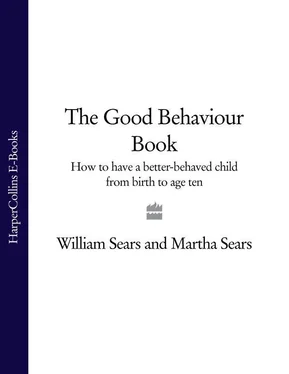the good behaviour book
How to have a better-behaved child
from birth to age ten
Dr William Sears and Martha Sears, R.N.
Edited by Caroline Deacon

Thorsons
An imprint of HarperCollins Publishers Ltd. 1 London Bridge Street London SE1 9GF
www.harpercollins.co.uk
HarperThorsons are trademarks of HarperCollins Publishers Ltd.
First published by Little, Brown and Company 1995
This revised and updated edition published in 2005 by Thorsons
Copyright © William Sears and Martha Sears 1995, 2005
William Sears and Martha Sears assert the moral right to be identified as the author of this work
A catalogue record of this book is available from the British Library
All rights reserved under International and Pan-American Copyright Conventions. By payment of the required fees, you have been granted the nonexclusive, non-transferable right to access and read the text of this e-book on screen. No part of this text may be reproduced, transmitted, downloaded, decompiled, reverse engineered, or stored in or introduced into any information storage retrieval system, in any form or by any means, whether electronic or mechanical, now known or hereinafter invented, without the express written permission of HarperCollins ebooks
HarperCollins Publishers has made every reasonable effort to ensure that any picture content and written content in this ebook has been included or removed in accordance with the contractual and technological constraints in operation at the time of publication
Source ISBN: 9780007198245
Ebook Edition © FEBRUARY 2014 ISBN: 9780007374304
Version: 2016-10-20
Cover
Title Page
Copyright
A Word About Discipline from Dr Bill and Martha
I: Promoting Desirable Behaviour
Chapter 1: Our Approach to Discipline
Styles of Discipline
Discipline’s Top Ten – An Overview of This Book
Chapter 2: Birth to One Year: Getting Connected
Martha and Matthew – How They Got Connected
Attachment Parenting – The Key to Early Discipline
How Attachment Parenting Makes Discipline Easier
Chapter 3: Understanding Ones, Twos, and Threes
How Toddlers Act – And Why
Talking with Toddlers: What They Can Understand, What They Can’t
Channelling Toddler Behaviours
Providing Structure
Going from Oneness to Separateness: Behaviours to Expect
Helping a Toddler Ease into Independence
From Two to Three
Discipline Gets Easier
Chapter 4: Saying no Positively
The Importance of Saying No
Creative Alternatives to “No”
Respectfully, No!
Making Danger Discipline Stick
Chapter 5: Taming Temper Tantrums
Why Tantrums?
Preventing Tantrums
What to Do When the Volcano Erupts
Handling and Preventing Tantrums in Older Children
Chapter 6: Fathers as Disciplinarians
Becoming a Dad: Bill’s Story
Eight Tips to Help Fathers Become Disciplinarians
Chapter 7: Self-esteem: The Foundation of Good Behaviour
Ten Ways to Help Children Build Self-Confidence
Chapter 8: Helping Your Child Express Feelings
Feelings: Expressing or Bottling Up?
How to Raise an Expressive Child
Chapter 9: Making Anger Work for You
Why Kids Get Angry
How Adult Anger Affects Parenting – And Discipline
Getting a Handle on Anger
Peace for Parents
Chapter 10: Feeding Good Behaviour
Foods That Bother Behaviour
Tracking Down Feel-Bad Foods
Chapter 11: Sleep Discipline
What Every Parent Should Know About Babies’ Nighttime Needs
Principles of Nighttime Discipline
Handling Common Nighttime Discipline Problems
II: Correcting Undesirable Behaviour
Chapter 12: Smacking – no? yes? Sometimes?
Ten Reasons Not to Hit Your Child
How to Avoid Smacking
Chapter 13: Discipline by Shaping Behaviour: Alternatives to Smacking
Praise
Selective Ignoring
Time-out
Help Your Child Learn That Choices Have Consequences
Motivators
Reminders
The Art of Negotiating
Withdrawing Privileges
Chapter 14: Breaking Annoying Habits
Steps to Breaking Habits (including nail biting, grinding teeth, twitching, lip biting, head banging, nose picking, hair pulling, and throat noises)
Thumb-Sucking
Chapter 15: Disciplining Bothersome Behaviours
Biting, Hitting, Pushing, Kicking
Dressing Discipline
Supermarket Discipline
Teaching Toothbrushing
Facilitating a Facewash
Whining
Clearing Up Dirty Words
Soiling Pants
Name-calling
Grumbling
Answering Back
Exciting the Unmotivated Child
Chapter 16: Sibling Rivalry
Introducing a New Baby
Promoting Sibling Harmony
Discouraging Sibling Disharmony
III: discipline for life
Chapter 17: Morals and Manners
Raising a Moral Child
Why Kids Lie – What to Do
Raising a Truthful Child
Encouraging Honesty
Stealing
Cheating
Teaching Your Child to Apologize
When Your Child Interrupts
Teaching Manners
Sharing
Chapter 18: Building Healthy Sexuality
Fostering Healthy Gender Identity
Modelling Healthy Gender Roles
Curious Little Bodies
Masturbation
Chapter 19: Discipline for Special Times and Special Children
Disciplining the Hyperactive Child
Disciplining the Temperamentally Difficult Child (aka the High-Need Child)
Disciplining the Special Needs Child
Parenting the Shy Child
Disciplining the Fearful Child
Discipline Following Divorce
Caregivers as Disciplinarians
Closing comments: Putting It All Together – A Sample Discipline Plan
Index
Keep Reading
Also by the Same Authors
About the Publisher
a word about discipline from dr bill and martha
Parents struggle with what discipline is and how to approach it. We all want our children to behave well, but the word “discipline” has connotations of corporal punishment and Victorian family values. In fact, discipline is a positive and integral part of your whole relationship with your child. It can’t be pulled out and isolated from the rest of your family’s life and does not need to be punitive – in fact, we would argue that it should never involve physical punishment. At one point we intended the title of this book to be Discipline for Life , because our purpose is to equip children with the tools they will need to succeed in life.
This book was written on the job. Many of the stories throughout this book are from our own family, and as you will see, discipline has not always been easy for us nor have we always done it right. We could never have written this book without the many years of parenting we have under our belt. It wasn’t until our kids started having kids that we fully realized the value of what we had done – and hadn’t done – as disciplinarians. Besides our own experience, much of the advice in this book comes from the real experts: veteran parents of disciplined children who over the years have shared their wisdom with us.
Читать дальше













